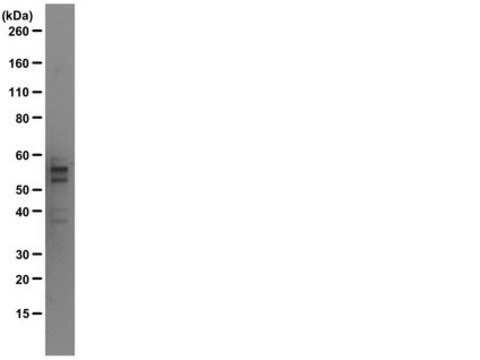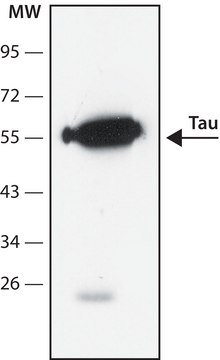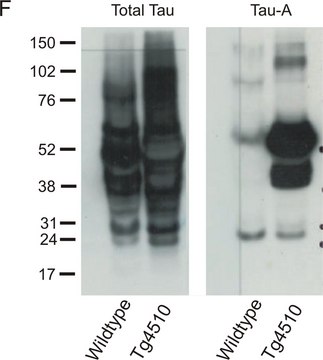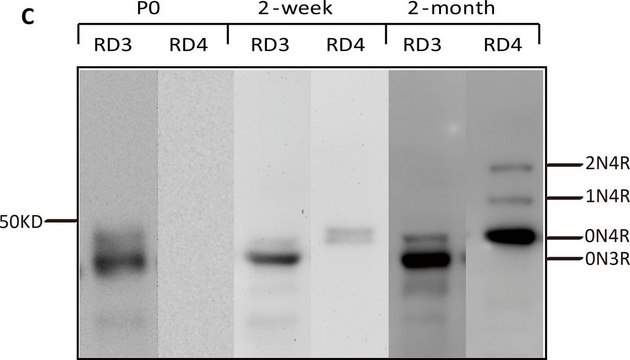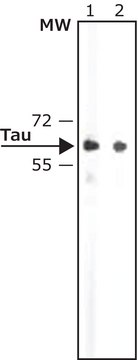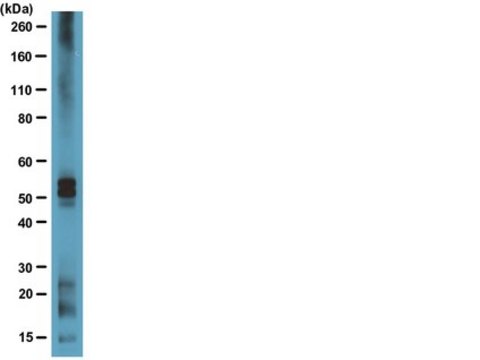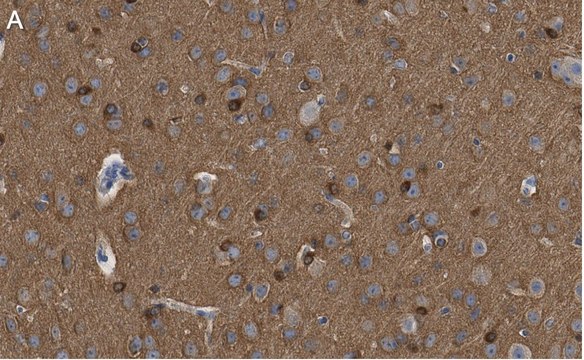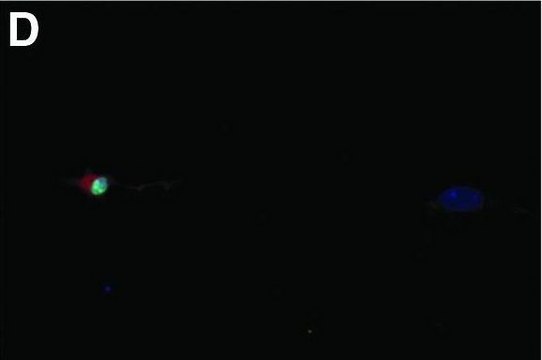推荐产品
产品名称
抗-Tau抗体(克隆T49,非人类), clone T49, from mouse
生物来源
mouse
质量水平
抗体形式
purified antibody
抗体产品类型
primary antibodies
克隆
T49, monoclonal
种属反应性
mouse, rat, bovine
请勿与下列物质发生反应
human
技术
immunohistochemistry: suitable
western blot: suitable
同位素/亚型
IgG1κ
NCBI登记号
UniProt登记号
运输
wet ice
靶向翻译后修饰
unmodified
基因信息
human ... MAPT(4137)
mouse ... Mapt(17762) , Mapt(281296)
rat ... Mapt(29477)
一般描述
Tau,或称微管相关蛋白Tau(MAPT),也称为神经原纤维缠结蛋白、双股螺旋细丝tau(PHF-tau),是一种细胞质蛋白,促进微管的组装和稳定,并可能涉及神经元中轴突极性(axonal polarity )的形成和维持。Tau 结合轴突微管,并被认为是轴突微管和神经细胞质膜成分的连接蛋白(linker protein)。该蛋白有多种亚型,短的亚型赋予细胞骨架可塑性,而较长的亚型可能在其稳定中起一定作用。PAD 是磷酸酶激活结构域(phosphatase activating domain),研究表明,其通过激活轴突蛋白磷酸酶1(PP1)和糖原合成酶激酶3(GSK3),以独立于微管结合的形式,参与基于驱动蛋白的、顺行性快速轴突运输(fast axonal transport,FAT)。Tau的缺陷被认为是许多神经退行性疾病的原因,包括额颞叶痴呆(FTD)、pallido-ponto-nigral degeneration(PPND)、皮克脑病(PIDB)、皮质基底节变性(CB)、核上性麻痹1型(PSNP1)、阿尔茨海默病和帕金森病。 克隆T49对于牛、大鼠和鼠类Tau有免疫反应性,但是对人Tau(分别为UniProt P29172、P19332、P10637、P10636)没有免疫反应性。
免疫原
纯化态对应于牛 Tau。
应用
免疫组化分析:一个代表性批次以的1:1,000 稀释液在小鼠大脑皮层、小鼠肾脏和小鼠小肠组织组织中检测到Tau。
蛋白质印迹分析:一个代表性批次在PBS处理的或FL a-syn pffs A株系或B株系转染的PS19神经元中检测到Tau(Guo, J.L., et al. (2013).Cell. 154:103-117)。
蛋白质印迹分析:一个代表性批次在PBS处理的或FL a-syn pffs A株系或B株系转染的PS19神经元中检测到Tau(Guo, J.L., et al. (2013).Cell. 154:103-117)。
抗-Tau 抗体(克隆T49)(非人类)是针对Tau 的抗体,用于蛋白质印迹和免疫组织化学。
质量
通过蛋白质印迹在人 脑组织裂解物中进行了评估。
蛋白质印迹分析:0.5 µg/mL的该抗体在10 µg小鼠和人脑组织裂解物中检测到Tau。
蛋白质印迹分析:0.5 µg/mL的该抗体在10 µg小鼠和人脑组织裂解物中检测到Tau。
目标描述
观测值〜53 kDa。该抗体具有45-76 kDa的多种亚型。
外形
形式:纯化
其他说明
浓度:请参考特定批次的数据表。
未找到合适的产品?
试试我们的产品选型工具.
储存分类代码
12 - Non Combustible Liquids
WGK
WGK 1
闪点(°F)
Not applicable
闪点(°C)
Not applicable
Sheng Chen et al.
Nature communications, 15(1), 2436-2436 (2024-03-19)
Parkinson's disease (PD) is closely linked to α-synuclein (α-syn) misfolding and accumulation in Lewy bodies. The PDZ serine protease HTRA1 degrades fibrillar tau, which is associated with Alzheimer's disease, and inactivating mutations to mitochondrial HTRA2 are implicated in PD. Here
Sarah Helena Nies et al.
The Journal of biological chemistry, 297(4), 101159-101159 (2021-09-05)
In Alzheimer's disease (AD), deposition of pathological tau and amyloid-β (Aβ) drive synaptic loss and cognitive decline. The injection of misfolded tau aggregates extracted from human AD brains drives templated spreading of tau pathology within WT mouse brain. Here, we
Elena Ficulle et al.
Scientific reports, 12(1), 2673-2673 (2022-02-19)
Cellular models recapitulating features of tauopathies are useful tools to investigate the causes and consequences of tau aggregation and the identification of novel treatments. We seeded rat primary cortical neurons with tau isolated from Alzheimer's disease brains to induce a
Antigoni Katsikoudi et al.
The Journal of biological chemistry, 295(37), 13079-13093 (2020-07-24)
Tau aggregation and hyperphosphorylation is a key neuropathological hallmark of Alzheimer's disease (AD), and the temporospatial spread of Tau observed during clinical manifestation suggests that Tau pathology may spread along the axonal network and propagate between synaptically connected neurons. Here
Michael Fassler et al.
Cells, 12(11) (2023-06-10)
TREM2 is a membrane receptor expressed on microglia that plays a pivotal role in the organization and function of these innate immune cell components within the neurodegenerated brain. Whereas TREM2 deletion has been studied extensively in experimental beta-amyloid and Tau-based
我们的科学家团队拥有各种研究领域经验,包括生命科学、材料科学、化学合成、色谱、分析及许多其他领域.
联系技术服务部门